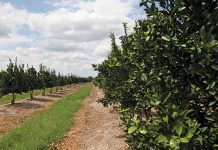Markets worldwide have been caught in the fallout of the US financial crisis.
With commodity prices under threat, farmers must play it safe.
The recent US financial crisis has increased uncertainty in other financial markets, and farmers must exercise caution in making financial decisions.
Negative comments from US Federal Reserve chairperson Ben Bernanke, a poor earnings report from Merrill Lynch and disappointing housing sales data confirmed, triggered the crisis in the very nervous US market. Share values decreased sharply on many stock exchanges. Stock prices fell more than 7% in Germany and India, 5,1% in China, 5,5% in Britain and 3,9% in Japan.
SA stocks followed suit. By noon on Friday the All Share Index, that provides a weighted value of all shares traded on the JSE, was down 2,23% to a level last seen in August 2007.
The US government was quick to counter the trend with a large cut of 0,75 percentage points in interest rates. But, as US commentators point out, a lower interest rate alone doesn’t go far enough. Iit doesn’t limit the number of repossessions, change bad loans into good loans or create new optimism amongst consumers, despite President Bush’s fiscal stimulus plan of US5 billion to restart the US economy.
What caused the crisis?
The sub-prime lending crisis has been looming for a long time. A sub-prime loan is a loan to a borrower who doesn’t qualify for a loan at best market interest rates because of a bad credit history, low income to debt service ratio and a high loan value relative to the value of the property. These borrowers are therefore known as sub-prime lenders. Hhowever, as these loans are riskier, they pay higher interest rates – it is the loan that is sub-prime, not the interest rate.
Sub-prime lending is risky for the lender and for the borrower, due to the combination of high interest rates and little or no spare capacity to increase monthly payments if interest rates increase, or to maintain payments if income decreases.
Since the 1980s, various methods have been developed of packaging sub-prime loans into complex financial instruments that provided investors with higher interest rates when the rates on more conservative investments were low. These also enabled banks to shift loans from their balance sheets.
The sub-prime market expanded further because of sales pressure by sub-prime lenders and the use of questionable practices such as loans at low initial rates, with no explanation to the lenders about the effect when higher interest rates kick in.
Higher US interest rates soon resulted in thousands of borrowers defaulting, and soon many sub-prime lenders were filing for bankruptcy. As a result, credit conditions tightened in many countries and availability of credit on world markets decreased. Foreclosures increased the supply of houses while demand shrank. US property prices dropped suddenly, and the close integration between the US and other financial markets resulted in contagion of most other financial markets.
Outcomes and implications
At the time of writing the outcome still remains uncertain. The US economy may still move into a real recession, but the US may manage to stem the tide and prevent this by combined monetary and fiscal actions.
A recession is defined as two quarters of negative growth. Aalthough the US economy’s growth may slow significantly from the 1,9% predicted by the International Monetary Fund (IMF) in July 2007, it’s doubtful whether this will indeed result in negative growth. In fact, some US commentators believe their economy has already reached the bottom of the cycle and things can only improve.
The sub-prime crisis will definitely lower growth in many countries, which will in turn decrease demand for agricultural products. We may therefore see some easing of international product prices. Fruit, wool and mohair producers can therefore expect lower international prices. This will probably have less effect on international grain and livestock product prices. World stocks are at historically low levels and the growth of the US biofuel industry has produced alternative markets for grain, while higher grain prices and livestock product demand from the huge Cchinese and Iindian markets will bolster livestock product prices.
The slow-down of the US and other markets has already eased international oil prices somewhat. This trend may continue in coming months. We may thus see a return to lower oil prices although we will probably never see US/barrel again.
Effects on SA
The rand weakened against the dollar since the beginning of 2008, but since the prime crisis, it seems to be slowly returning to levels below Rr7 per US. Aa stronger rand will help limit increases in input prices. Aas a large part of our agricultural exports go to the EeU, and the rand is still deteriorating against the euro, the effect on SA product prices may be less than expected. The weaker US dollar will also result in higher dollar prices for commodities.
The real effect on SA agriculture depends on the US’s ability to manage the crisis and on whether the SA authorities prevent the same thing happening here. Under these conditions farmers must make financial decisions with due care.
Dr Koos Coetzee is an agricultural economist at the MPO. All opinions expressed are his own and do not reflect MPO policy.








